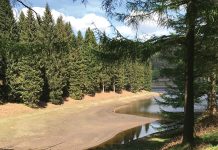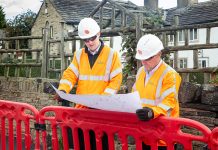Severn Trent Water (STW) is one of the largest water companies in England and Wales, providing water supply and waste water treatment services for over eight million customers. The organisation’s boundaries are defined by the fluvial catchments of the Rivers Severn and Trent, and the company manages the water cycle in central England.
A fascinating diversity of over 700 dams and reservoirs, constructed over the last 170 years, form a key component of the strategic infrastructure. Of these, 62 of the company’s reservoirs are classed as “Large Raised Reservoirs” as they retain more than 25,000m3 of water above natural ground level in England and more than 10,000m3 in Wales and are, therefore, regulated by the Reservoirs Act 1975.
For a water company, the key role of the reservoir is to store a year round supply of raw water to supply the treatment process. The average age of STW Large Raised Reservoirs is 82 years, compared with 120 years nationally. The majority are impounding reservoirs (reservoirs formed by damming a watercourse) and remainder are non-impounding (pumped storage) and service reservoirs.
Ian Hope, dams and reservoirs manager for Severn Trent, explains: “We currently design our civil structures to a minimum design life of 50 years. Design life can be considered appropriate for conventional civil engineering structures of say 60 years however the robustness and role of our dams leads us to drive continual improvements. This is also driven by the 10 yearly statutory inspection when the standard to which the dam is constructed is reassessed against todays standards and modified/ upgraded accordingly.
“The challenge facing the reservoir sector is how to maintain the serviceability of the assets with increasing age. There is a growing trend to undertake risk assessment of the portfolio of reservoirs owned by water companies, with differing methods being employed by different companies. Risk being a function of likelihood and consequence can lead to a great deal of money being spent on the assessment of the potential damage and loss of life downstream of the reservoir in the event of failure. To a water company however, the raw water reservoir has failed to achieve its requirement to store water for the supply of its customers if it needs to be drawn down for reservoir safety or unplanned maintenance. It is therefore our view that money is better spent understanding the potential causes of failure and reducing the likelihood of those occurring.”
New technologies are allowing greater understanding of how structures are performing. Piezometers have been installed in dams to monitor water pressures within the embankment fill or foundations and drainage flows have been measured and plotted for many years. These instruments provide useful information but only when they are read which may be on an infrequent basis. It is now cost effective to install remote, real time monitoring that can send automated alarms via SMS to the mobile phones of key staff with the instruments powered by solar and with signals sent using the mobile network to avoid the costs of cabling a power and telemetry link. Whilst still needing the oversight of a competent assessor, it can highlight an emerging issue which may not have been spotted for weeks or months if relying on manual readings.
Ian continues: “The increasing use of drones enables greater inspection than previously possible. We have used a drone to undertake crack surveys of the downstream face of Clywedog in one day which previously took a team of four abseiling up and down the dam for five days. This eliminated the need for working at height therefore making the operation safer and gave comparable results to the previous survey.
“Fibre optic cables are occasionally used for monitoring leakage from structures through being able to determine temperature difference. This has been used at several raw water reservoirs in the UK however at STW, we see that this has potential to identify the source of leakage and ingress at service reservoirs. Whilst we have yet to install fibre optics for leakage detection, it is planned for several of the service reservoirs under construction using pre-cast wall sections in AMP6 as these structures have more joints than a traditional in situ construction. This will allow better understanding of the performance of the structure to inform future investment decisions.
“The data available from satellite technology is improving year on year. Improvements in the field are rapid and so whilst not being cost effective currently, we are reviewing and we have little doubt that the use of satellites will become commonplace in the industry in the future.
“Although there are emerging technologies able to assist the reservoir engineer, there is still nothing that has been invented that beats a trained and competent person at undertaking surveillance on the whole of the reservoir and its structures. A piezometer may note a water pressure change in a part of the dam, but it is limited to its area of influence and so if the leak is appearing in an area without instrumentation, the structure may still be failing. A trained operator is able to take a holistic view of the reservoir and therefore manage the risk posed by the asset which is often one of the bigger risks held by the company. In order to maintain the serviceability of our reservoirs, the training of our staff to ensure high quality surveillance and employing new technologies run hand in hand to ensure that we continue to manage our reservoirs so that they are always able to provide water to the customer.
“As well as reservoirs being key in the water supply side of the business, a lot of our reservoirs are open to the public as recreation spaces. Reservoirs have significant amenity value in a community. They may be used for fishing, sailing, walking, cycling and many other uses and our sites have millions of visitors per year. These reservoirs can become havens for birdlife and provide habitat for other flora and fauna. We can also use these sites as places to advertise our key customer messages such as sewer misuse and water efficiency. This is a great opportunity for a utility to publicise the good work that we do.
“Many people only think of their water company when the bill arrives or when they are digging up the road. We can be complacent to the essential nature of a reliable water and sewerage service until something goes wrong and then suddenly the company becomes terrible, with people forgetting all of the good work that is going unnoticed. Hopefully by opening up our reservoir sites for people to see, it will remind everyone what an essential service their water supply is, and how important our reservoirs are, not only in providing that essential supply, but for the local environment too.”





